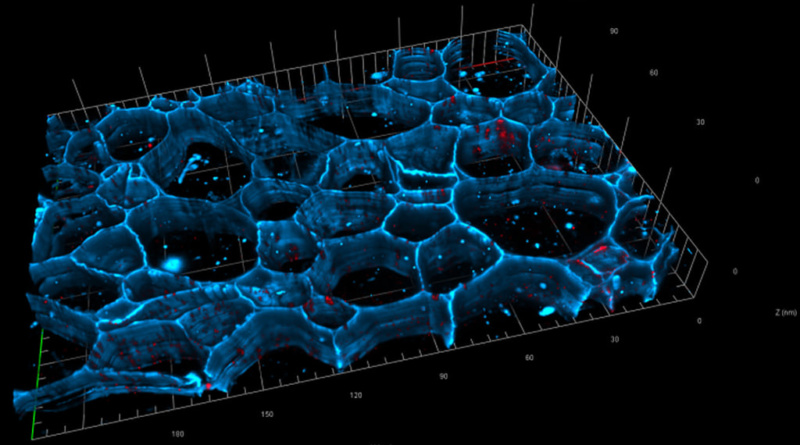Beauty And The Microscope: What Science Can Learn From Art

Hannah Imlach/Heriot-Watt, CC BY-SA
Paul Dalgarno, Heriot-Watt University
As a scientist, I consider myself artistic in neither my abilities nor my observations of the world around me – I am a physicist who has dedicated his career to controlled experiments, mathematical descriptions and quantifying all I observe. I’ve always seen art as the converse – as something unquantifiable and fundamentally opposite to science.
But a recent collaboration with Hannah Imlach, an artist-in-residence here at Heriot-Watt University, has caused a dramatic change in my opinion, making it clear to me that science and art are inherently interconnected and that science can learn much from the world of art.
Microscopy is one of the highest-impact innovations in the history of science. With origins in the 1600s and the earliest parts of the scientific age of enlightenment, microscopy has evolved to underpin almost all aspects of modern science. The largest impact is arguably in the life sciences, where the ability to observe the complex, transient and dynamic world of the single cell has revolutionised healthcare, quality of life and fundamental understanding.

Hannah Imlach/Heriot-Watt, CC BY-SA
Today’s microscopes include Nobel Prize-winning fluorescence and super-resolution techniques which together have pushed microscopy into a new era, allowing us to see more detail than ever before. We can study highly specific parts of the living cell in real time and create computer models of this activity. We have reached the stage of being able to offer a direct and measurable description of the cellular world.
Within the complex world of the cellular microscopist, the essence of the microscope is often lost, the amazing beauty and elegance of the technology overlooked. Sometimes it is important to step back and take stock of what the imaging delivers. As scientists we focus on the all-important push to quantify data, often forgetting to ask ourselves what it is, in fact, we see when we look through the eyepiece.
Common ground
The Institute of Biochemistry, Biophysics and Bio-engineering at Heriot-Watt University was awarded a Leverhulme Artist in Residence grant that allowed Hannah Imlach, a visual artist working primarily in sculpture, to work and study within our institute for a year. By fully immersing herself in our research environment, Hannah could shadow researchers and seek inspiration for new works that reflected the modern research and applications of microscopy.
A scientist collaborating with an artist seems a challenging idea. Interdisciplinary science and communication are central to modern science – and deservedly so – but the boundary between art and science is somewhat unbridged. Where do you begin – and where is the common ground?
To start, both scientist and artist shared a passion for observing the visual beauty of cells that are seen down a microscope. As the art was to be functional and sculptural, there was shared excitement in building prototype optical systems. These included various projection systems and large microscopes, all designed to merge the microscopy instrumentation with an artistic vision of the data being studied.
However, true overlap between the scientific and artistic process came in an entirely unexpected way, when the artist showed her sketchbooks to the scientists.
These were lovingly referred to as “lab books” by the scientists, and visually documented every thought and process being explored as the concepts and ideas formulated themselves into understanding and eventually structure. This was a developmental and thought process with direct parallels to the scientific method – and it led to a profound realisation on my part.

Hannah Imlach/Heriot-Watt, CC BY-SA
Head and heart
Whereas scientists may document their results and meticulously record and detail the analysis and discussions, they rarely do the same for setting out their ideas. It’s “all up here in my head” and rough paper and temporary whiteboard sketches often suffice. In this project, the artistic idea was laid bare and what was clear that within it was the very essence of how a scientific idea is born and brought to fruition.
In the same way, both scientist and artist follow a shared methodology: the first hypothesis, the uses of the base knowledge, abandoned ideas, initial results, interpreting them and developing them – all before evolving into the final experiment and results.
The so-called artistic process, seemingly uncoordinated and disorganised, mirrors the scientific process, only in this case it was more elegantly drawn and documented. It became clear that science and art can be the same – and that ultimately they are based on thoughts, ideas and passion. It’s only how we end up formulating those ideas and presenting our conclusions that actually differs.

Hannah Imlach/Heriot-Watt, CC BY-SA
Hannah’s piece, Fluorescence Projector, allows the viewer to fully immerse themselves in the world of super-resolution fluorescence microscopy. It projects real data through a water-filled ball lens, inspired by the early 1600s microscopes, and reformulates the image into a floor projection screen. By intentionally allowing optical aberration and vibration to impart themselves on the sculpture, the viewer can interact and seek depth within the projected data.
This has left me asking the question: how do we process scientific observations? How do we develop our ideas, and transfer these to experiment, to understanding and then disseminate? These are simple questions, but ones that need to be considered.
![]() The truth is it’s a messy process, fluid and interpretive. It requires intuition and hunches, but most importantly, inspiration and a connection to the work that runs deeper than textbook understanding. Put simply, it’s artistic, and for me, the scientist, it took working directly with an artist to see just that.
The truth is it’s a messy process, fluid and interpretive. It requires intuition and hunches, but most importantly, inspiration and a connection to the work that runs deeper than textbook understanding. Put simply, it’s artistic, and for me, the scientist, it took working directly with an artist to see just that.
Paul Dalgarno, Assistant Professor in Physics, Heriot-Watt University
This article was originally published on The Conversation. Read the original article.





